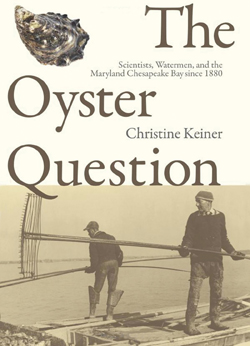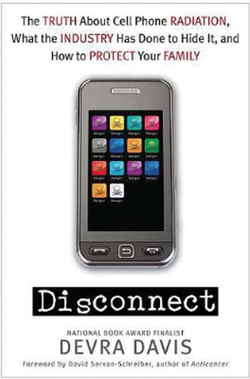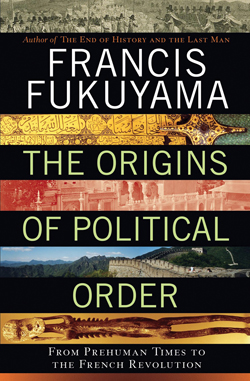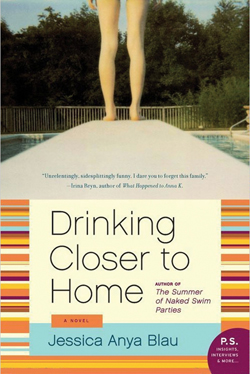
The idea was to pull together a list of great hot-weather reads penned by Johns Hopkins faculty and alumni. Books that would be light and intellectually airy and perfect for tucking under your arm on the way to the pool. You know, vacation reading—engaging but nothing you’d take notes on.
Well . . . It turns out that Johns Hopkins doesn’t do light and airy, at least not that often. And you probably wouldn’t want to read an entire summer’s worth of those books anyway. So instead, we worked our way through the stack of impressive Hopkins-affiliated tomes on the editors’ desks, looking for titles that promised a good read, even if they required a little effort. What did we find? A book about Maryland oysters and their gradual demise, scary cell phone science, a poetry book, a history of liberal democracy, and psychiatrists’ truth-telling about their profession. We even found a novel. We don’t expect you to read every book on the list, and we wouldn’t really recommend taking more than one or two with you on a cruise unless you’ve got a Kindle.
Look at it this way: It’s summer. Things are slowing down, vacation lies ahead. You’ve got a little extra time. Use it smartly.
Shucking open a tale
A little local (science) history about Maryland’s favorite mollusk
You can see a whole world in an oyster. (And by that, I don’t mean a perfectly milled pearl.) Just ask those who have made extraordinary claims, often competing ones, about Crassostrea virginica, the prized Eastern oyster—a culinary gem that once encrusted the entire bottom of the Chesapeake Bay. For the watermen whose livelihoods have risen and fallen with it, the oyster has become the slimy symbol of the bay’s ongoing decline and their sad fortunes. For environmentalists, the humble bivalve embodies perhaps the last chance to filter out tons of the harmful “nutrients” that come along with booming populations and large-scale shoreside agriculture. And for elected officials who have vacillated between bending over backwards for watermen or rolling over for corporate dredging-and-leasing interests, the oyster has provided a centuries-long conundrum: How much political capital can I expend (or gain) by coming down on one side or the other?
In the past century or more, Christine Keiner, A&S ’01 (PhD), writes in The Oyster Question, all the churning currents surrounding the oyster—the gustatory oyster, the economic-engine oyster, the political oyster—have hardly done it any favors. The bay now yields about 1 percent of the 15 million bushels it did annually around 1885. The phenomenon is not limited to the bay. Worldwide, 85 percent of natural oyster reefs are gone. Those that remain are about 10 percent as productive as they were during their historic peaks. To invoke the mollusk today entails a sigh and a shrug as much as a smacking of the lips.
Keiner, who investigated the machinations surrounding the oyster as ballast for her dissertation, comprehensively charts the course of its decline. From cannon-fueled wars between oystering boats in the 1880s; to a state districting system that endowed watermen early on with too much political power, encouraging overfishing; to battles between large-scale dredging operations and traditional hand-tongers (who decried those who would more completely exploit “the commons” of the bay’s bottom); to the melancholy surrounding the industry today, Keiner unstrings a yarn that is by turns bizarre, jaw-dropping, and maddening. While her painstaking book lacks the spark and sprawl of Mark Kurlansky’s 2006 opus, The Big Oyster: History on the Half Shell, which utilized the oyster as a prism through which to explore New York’s economic and social history, it gets at the questions oyster lovers have long asked: Why is it so hard for the oyster to stay healthy and reproduce? Why hasn’t science devised a way to turn its fortunes around?
Keiner also captures just how central the oyster became to the region’s cultural and economic identity, spurring new rail lines and canning industries, and encouraging health and ecological improvements. Baltimore became the first American city to build a wastewater treatment plant, not because of water quality concerns, she notes, “but to protect the lucrative oyster trade from sewage contamination.”
Woven throughout Keiner’s historiography is the Crassostrea-centric work of three Johns Hopkins giants who introduced the voice of science into the ongoing what-shall-be-done debate over the oyster, and maintained it for decades. In doing so, they furthered the university’s interest not only in highlighting its research locally, but aiding the state economy. One of them, William K. Brooks, a late 19th-century biology professor, investigated ways to artificially reproduce oysters, and argued in favor of turning over large chunks of the bay bottom to the seaside equivalent of the mechanized agriculture that had reshaped the North: corporate interests and small-time operators with incentive to tend to the beds and reefs.
Two others—Abel Wolman, Engr ’15, known globally as the godfather of water purification, and Isaiah Bowman, a geography professor—made similar arguments later (as did a young environmental journalist, Rachel Carson, A&S ’32, during the 1930s). None of them got what they wanted—to the delight of oystermen, who long and viciously fought privatization of the bay.
The Hopkins trio was certainly well intentioned, Keiner implies, but they probably were wrong about what could save the oyster. She points to another embattled concept—climate change—as a possible culprit for the bivalve’s ongoing demise. As warmer waters made their way up the bay, so did the viruses that killed or stunted the oyster’s growth. By the 1980s, the plummeting catch had turned oystermen into crabbers, charter boat captains, and prison guards. “Today’s working fleet can be counted on one hand,” Keiner laments.
The world of the estuary may no longer be our oyster, but that doesn’t stop all interested parties from eagerly awaiting word of a revival. Bay harvests in 2010 were still measly, but the numbers of disease-resistant spat—larval oysters—were on the uptick. All of which proves that while the salty, sought-after critters’ best days are likely behind them, they can always inspire hope.
—Michael Anft
Hold the phone?
What you didn’t want to know about your mobile device
I just joined the gazillion cell phone users on the planet and bought one, a fancy 4G model that meets my every communication/information/entertainment need. Then I opened the flyleaf of Disconnect, by Devra Davis, SPH ’82, and read the flat statement, “Cell phones are not safe.” What’s a person to do? What are a gazillion people to do?
Davis, who holds a PhD in science studies and an MPH in epidemiology, writes a lively, readable book explaining cell phones’ lack of safety. First, she’s careful with a caveat: The frequencies of electromagnetic radiation used in cell phones are in the microwave range, orders of magnitude less energetic than the x-ray and ultraviolet radiation that clearly break the bonds of DNA and thereby can cause cancer. Whether microwave frequencies can otherwise affect human health, though, is a vexed subject. Many studies have been done, many find no harm, they all have limitations, and they may or may not contradict each other.
For example: The DNA in the brains of rats exposed to radio frequencies (those longer than microwaves) show some sort of damage. Rats exposed to microwave frequencies can’t remember how to get out of their swim tanks and just swim in circles. Radio frequencies can penetrate a few centimeters into the human brain. Russian children who use cell phones have problems with learning and behavior. Men who keep cell phones in their pockets have lower sperm counts. A large study of cell phone users in Denmark found no higher incidence of brain tumors, but Davis objects that the results weren’t analyzed for amount of use. Another large study of people around the world who had brain tumors found no correlation with cell phone use, though the study ended in 2004 and since then cell phone use has risen dramatically. Most epidemiological studies find no increased risk of brain tumors, Davis says, but “those few studies” that follow heavy users for a decade do.
An April New York Times article made an extensive case that cell phone research was at best inconclusive: “Thus far, this extraordinarily wide-cast net has yet to find solid proof of risk for cell phone radiation,” wrote author Siddhartha Mukherjee of the large body of research to date. “Not a single trial or test that has attributed carcinogenic potential has been free of problems. Population-wide studies have failed to demonstrate an increased incidence; retrospective trials have been contradictory and riddled with biases; animal studies negative; human physiological experiments inconclusive; cellular studies inconsistent and weak.”
Yet Davis is clearly a believer. Her language is emotional; she intersperses her arguments with hair-raising anecdotes of people who used cell phones heavily and got brain tumors. She weights small, dicey studies that show dangers equally with large, more controlled studies that don’t. She interviews a number of scientists, all of whom cite the uncertainties and dangers of cell phones. Scientists who remain unconvinced by the dangers, she implies, are influenced by the multibillion-dollar cell phone industry.
In fact, it all sounds like the argument over climate science: The possibility of harm is great; the debate is partisan, emotional, and cherry-picks its scientific evidence; the science is necessarily incomplete and hard for the innocent bystander to assess—partly because that partisan debate gets in the way. And all I want to know is, what to do about it now?
Ask the feds: The government regulates cell phones via the Federal Communications Commission and the Food and Drug Administration. Davis argues that the regulations were set up over a decade ago and without accounting for children’s smaller heads and developing brains. But the websites of both agencies advise what Davis herself advises: If you’re worried, limit use and either put the phone on speaker or use a headset; get your children to do the same. The cell phone industry agrees, but in small print.
Ask the usually neutral National Research Council: It reviewed the research and advised scientists what to do next. Study the health of people with “long-term, low-intensity” exposure. Figure out whether children are more susceptible, especially given that more of them are using cell phones earlier. And do the fundamental science: controlled, replicable studies of exactly how microwaves might affect cells and at what doses.
Meanwhile, for the case against, ask Davis.
—Ann Finkbeiner
Beautiful and taxing
A book of poetry that’s worth the effort
Grinnell College in Iowa, Amy Clampitt’s alma mater, once prevailed upon her to answer the question, “What do you need to know to be a writer?” The poet’s response was an essay, “Predecessors, Et Cetera,” written in 1986 and answering the college’s query in the essay’s last paragraph: “In one word, I’d say, predecessors. There is less originality than we think. There is also a vast amount of solitude. Writers need company. We all need it. It’s not the command of knowledge that matters finally, but the company. It’s the predecessors. As a writer, I don’t know where I’d be without them.”
In the years since Clampitt’s startling 1983 “debut,” The Kingfisher, critics have compared her to a gallery of predecessors (with a few contemporaries tossed in) that bespeaks their admiration: John Keats, Gerard Manley Hopkins, Walt Whitman, Wallace Stevens, Hart Crane, Marianne Moore. The Kingfisher, technically her third published volume of poetry but the first by a major publisher and the first one that anyone noticed, came out when its author was 63 years old. Clampitt got a late start as a major poet, but before she died in 1994, she created a body of substantial work that has won a legion of admirers.
Mary Jo Salter, professor in the Krieger School’s Writing Seminars, knew Clampitt for 15 years, from when she first wrote her a fan letter as a 24-year-old editor at The Atlantic Monthly. Clampitt responded to young Salter’s note immediately and generously, and the two became friends. Thirty-one years later, Salter edited Amy Clampitt: Selected Poems.
Do not approach an Amy Clampitt poem, even one of the shorter ones, without sufficient time and patience to read it five or six times. Your labor will be rewarded as, by the fourth or fifth reading, you begin to appreciate the working of an erudite, alert, reflective, active mind as it wielded memory, extraordinary powers of observation, decades of astute reading, and strong beliefs to create what critic Helen Vendler once accurately called “a beautiful, taxing poetry.” Nor should one approach a Clampitt poem without a good dictionary. Her vocabulary in the verse collected by Salter in Selected Poems is extraordinary (and irritating to some of Clampitt’s detractors, including poet and memoirist Mary Karr). The first 10 or so poems in this anthology yield the following list: dado, trig, panicle, corolla, campanula, filigree, plissé, lacuna, gall (the verb form), ruching, echinoderm, cumber, chrysoprase, damascene, transhumance, and coracle, all employed with precision and sometimes digging into deeper historical recesses of the English language. In “Gradual Clearing,” Clampitt wrote: “Late in the day the fog / wrung itself out like a sponge / in glades of rain, / sieving the half-invisible / cove with speartips.” Look up sieving in most dictionaries and you’ll find only a verb meaning, “to pass through a sieve, to sift,” which makes no sense here. But consult the Oxford English Dictionary and you’ll find a 19th-century meaning, “to perforate with holes.”
Salter has compiled a generous and judicious miscellany, selecting verse from all five of Clampitt’s books and a bit of her unpublished work. There is the 12-line “Dallas–Ft. Worth: Redbud and Mistletoe” and all of the eight-poem sequence “Voyages: A Homage to John Keats.” Bolstering the collection as a sort of appendix are notes that Clampitt herself wrote for each of her books, notes in which she might describe her puzzlement on first encountering a sea mouse, explain that spleenwort is a kind of fern, or record that some Iowans claim that an anonymous Iowa farmer invented barbed wire.
Ask me for an exemplary poem and I might suggest “Procession at Candlemas.” The narrator is on a long, sad drive, back to her childhood home, back for her mother’s funeral, “bereavement altering the moving lights / to a processional, a feast of Candlemas.” Candlemas celebrates the purification of the Virgin Mary, and Clampitt wryly notes, “such a loathing / of the common origin, even a virgin / having given birth, needs purifying.” The poet’s eye notices the name of a highway rest stop, “Indian Meadows,” and her dexterous mind leaps to another sad procession of indigenous Americans driven from the land in “westward-trekking transhumance,” transhumance—“transfer of livestock”—the perfect word for both its denotation and the meaning lurking in its sound. On into the Midwest, the grieving driver rolls through morning “grey as zinc” and past “the sullen stare of feedlot cattle,” driving “in falling snow, the stillness and the sorrow / of things moving back to where they came from.”
—Dale Keiger
Getting to Denmark
A hefty intellectual history of liberal democracy
The Arab invention of military slavery in the mid-ninth century was a “brilliant” counterweight to tribalism that may have saved Islam as a major world religion. Europe became the cradle of liberal democracy in part because the Roman Catholic Church systematically severed family bonds in the Middle Ages. And China, home to the world’s first modern state, has never known the rule of law or accountable government because of its weak religious foundations.
These are just some of the provocative conclusions former Johns Hopkins political scientist Francis Fukuyama draws in The Origins of Political Order, an epic tale of how political institutions developed from prehuman times to the dawn of modern politics after the American Revolution.
Fukuyama wrote this first of two planned volumes while he was a professor at the Nitze School of Advanced International Studies. (He is still a senior fellow at SAIS’ Foreign Policy Institute.) A former Reagan State Department official who influenced and then distanced himself from the neoconservative movement, Fukuyama is now at Stanford University.
Readers expecting a polemic from the author of 1992’s The End of History and the Last Man will find instead a dispassionate and engaging mix of anthropology, economics, and intellectual history. As in the older book, liberal democracy is held up as the apotheosis of human political organization, but here Fukuyama wants to explain why some societies made it there and others didn’t “get to Denmark.”
For Fukuyama, liberal democracy has three essential ingredients: a sovereign state, a rule of law that transcends state authority, and an accountable government. He moves from chimpanzees to the world’s major human societies to explore how various major civilizations acquired, or failed to acquire, these three qualities.
Fukuyama’s central thesis is that human beings are inherently social creatures with biological attributes that encourage bonding. As agricultural production forces people to live near each other and share common resources, nuclear families band together with cousins who share similar ancestor-worship religions. Kinship groups throughout history have resisted the centralized authority of strangers but relented when geographical constraints and the threat of violence persuaded them to submit to protective sovereigns in territory-based states.
A main force that drives societies from a “tyranny of cousins” to the modern state is religion, according to Fukuyama. “It is hard to see how human beings could have evolved beyond small band-level societies without it,” he writes, because the worship of a common supernatural authority makes it easier for people to forsake tribal allegiances. Strong religions also create rules that transcend secular authority, readying the ground for the rule of law that is the second leg of Fukuyama’s democracy tripod. And when central authorities are well matched against strong legal traditions, governments evolve toward accountability, the third ingredient.
Thus, China, which developed the first modern state and bureaucracy as early as 770 B.C., “never succeeded in suppressing the power of kinship on social and cultural levels” and therefore failed to create a rule of law to balance authoritarian rule. Early Arab and later Ottoman rulers, on the other hand, bypassed potentially competing kinship bonds among the tribal population by enslaving foreign boys, converting them to Islam, and raising them to be elite members of a warrior class. And the statelike Catholic Church and its legal system in the Middle Ages taught kings that they were not above the law—a lesson that would be critical for accountable governance to emerge.
While holding up the accomplishments of liberal democracies like the United States as an ultimate goal, Fukuyama cautions that one lesson of his comparative survey is to be ever vigilant against the constant threat of political decay, suggesting darkly that the U.S. political polarization and deficit are red flags. “Once a society fails to confront a major fiscal crisis through serious institutional reform,” he writes, “it is tempted to resort to a host of short-term fixes that erode and eventually corrupt its own institutions.”
Fukuyama will no doubt delve more deeply into these matters in his second volume, which will tackle political development in the contemporary world.
—Gadi Dechter
Psychiatrists talk shop
A frank discussion of the field, with the doctors who practice it
What is the difference between psychoanalysis, psychotherapy, and psychiatry? Why do psychiatrists respond to patients’ questions with a question? Do psychiatrists still use shock treatments? How, exactly, does the insanity defense work? What’s so bad about Xanax, anyway? Psychiatrists Dinah Miller, Annette Hanson, and Steven Roy Daviss answer these questions and more in Shrink Rap, their straight-talking guide to psychiatric care.
When Miller, a consulting psychiatrist for the Johns Hopkins Community Psychiatry Program, returned home after spending two weeks in Louisiana working with Hurricane Katrina victims, she needed to write. “At first I couldn’t write, and then I couldn’t stop writing,” she says. So, along with two tech-savvy colleagues—Hanson, a prison psychiatrist with appointments at Johns Hopkins Hospital and the University of Maryland, and Daviss, a hospital-based psychiatrist and assistant professor at the University of Maryland School of Medicine—she created the blog Shrink Rap. On the heels of their blog’s popularity and at Daviss’ insistence, the doctors also embarked on a podcast, which they named My Three Shrinks.
The book grew out of these successful efforts. In it, readers are afforded a “behind the curtain” view of psychiatry from the eyes of patients and from the perspectives of doctors. Each chapter begins with a brief narrative vignette that anchors the information in real-life experiences. Meet Eddie, for example, a young man suffering from mental illness who is arrested on rape charges. Instead of talking in abstract terms about psychiatry in the correctional system, the authors follow Eddie’s story from the time he is a middle school student diagnosed with ADHD through his difficult teenage years with an unstable home life to his struggles with substance abuse and eventual incarceration. Using his story as a jumping-off point, they explain concepts such as mental health court, antisocial personality disorder, forensic psychiatry, and why the insanity defense isn’t exactly a get-out-of-jail-free card.
Although the patients and doctors portrayed in the vignettes are fictional, the authors write, “it’s probably safe to assume that there is a little bit of us in these responses and reactions that we’ve borrowed from our own internal lives to make our fictional psychiatrists all the more real.” In a profession where they are required to be a blank slate—not cultivating friendships with their patients or divulging details about their own personal lives—they remind us that shrinks have feelings, too.
Shrink Rap provides a little something of everything. Because the authors work in diverse areas of psychiatry—Miller works in clinic settings and has a private psychotherapy practice, Hanson works in a correctional facility, and Daviss works in ER and hospital settings—they each bring a distinct area of expertise to the issues they tackle. The authors have an easy rapport, occasionally trading jokes with one another on their blog and in their podcast episodes. The book reflects their collaborative effort and offers insight into a number of different issues and settings. The doctors see eye to eye on many things; however, they don’t shy from issues that psychiatrists often disagree on. In fact, an entire chapter is devoted to “Things We Argue About,” covering everything from health care reform to medical marijuana to which disorders should (or shouldn’t) be included in the Diagnostic and Statistical Manual of Mental Disorders.
Reading this book is like having a significant other who happens to be a psychiatrist—it’s more information than you’d get talking to someone at a cocktail party, but at 272 pages, it avoids being as dense or exhaustive as a textbook. Miller, Hanson, and Daviss confide the things that frustrate them (convoluted insurance practices that hinder good patient care) and the shortcomings of their field (disagreement over classifying disorders). Using this tell-it-like-it-is approach, they demystify psychiatric practices that have long been stigmatized, such as electroconvulsive therapy (which, as it turns out, is still used today, although it looks nothing like the punishment wielded by Nurse Ratched in One Flew Over the Cuckoo’s Nest). They also shed light on the insurance process, explaining why a patient might be stuck waiting hours in an ER and why some private practice psychiatrists don’t accept health insurance.
Although they explain psychiatry in all its merits and failings, acknowledging the limitations of their field, these are clearly three shrinks who love their jobs. “This is an exciting time to be a psychiatrist,” they write. “It is also a hopeful time for our patients.”
—Kristen Intlekofer
Fun with the family
A novel, at last . . .
Drinking Closer to Home, by Jessica Anya Blau, A&S ’95 (MA), is a diverting summer read—a story of three quirky adult siblings, Anna, Portia, and Emery, who are thrown together after their chain-smoking, pot-toking artist mother, Louise, suffers a heart attack. The time is 1993, that surprisingly recent and laconic era before cell phones, tablet computers, and Google. In their childhood home in the hills of Santa Barbara, the children reflect on their past and their relationships with each other. Anna, the oldest and most confident, is a recovering sex addict who struggles to stay true to her marriage vows. Portia, the prudent middle child, laments that her husband has left her for a younger woman. Emery, a gay television executive, arrives with Alejandro, his partner; the two men are hoping that one of the sisters will donate eggs for an embryo to be implanted in a surrogate mother. Buzzy, the quiet patriarch of the clan, has a secret that he’ll no longer be able to keep from his children. Nothing really happens in this entertainingly fitful story but the remembrance of pop-culture moments past. Sit back, put some Beach Boys in your iPod, and enjoy.
Drinking Closer to Home jumps back and forth in time between 13 days spent by their mother’s hospital bed and 11 memorable episodes from 1968 to 1990—car trips and visits from strange relatives—evidence of a colorful childhood. Appropriate icons appear, signifying authenticity: The Courtship of Eddie’s Father in the late 1960s; Moshe Dayan and Texas Instrument calculators in the 1970s; coke and contraceptive sponges in the 1980s; Hillary and Bill in the 1990s. The flashbacks provide context for the children’s edgy relationship with their mother and balance the static, reality TV mood of the present, where the siblings bicker, cook, air old grievances, and wait to see if their mother will recover.
Blau’s narrator is as eccentric as her characters: “It has only been recently that Anna forgave her mother for a litany of crimes Anna had been carrying in her stomach like a knotted squid.” In her hospital bed, Louise’s lips “are like two dessicated slugs.” Emery’s words “are stuck in his throat like a lineup of golf balls.” Sometimes these similes are thrilling; sometimes they’re obtrusive and inapt. The story’s rhetorical quirkiness helps hold the reader’s interest. Drinking Closer to Home is not a novel with a palpable narrative arc; the only real source of tension is whether Emery and Alejandro will get their eggs.
As she did in her first novel, The Summer of Naked Swim Parties (2008), Blau flaunts her ability to describe odors, filth, and bodily fluids in stark detail. Readers should be warned: Nearly everybody vomits, pees, poops, and oozes. As the family moves from Michigan to Santa Barbara in a blue station wagon with a playpen in the way-back, baby Emery hurls in his sisters’ hair. In California, the pet cockatiel escapes to the curtain rod to spend years encrusting the living room couch with its droppings. Portia’s mattress is “slick and shiny-gray from body oil and dirt.” Louise relieves herself by standing next to the family car and lifting her skirt. The hospital scenes are gratifyingly sanitary and refreshing.
Drinking Closer to Home inhabits the narrative space between the unanticipated and the unexpected: The reader expects that quirky things will happen to the characters (this is the whole point of her novel) but cannot guess precisely what these things will be. The story is not without its surprises, though more might have happened, and perhaps Buzzy, the father, might have been more fleshed out. But the pleasure of Blau’s novel is in the details, offbeat but often on target.
—Hollis Robbins






